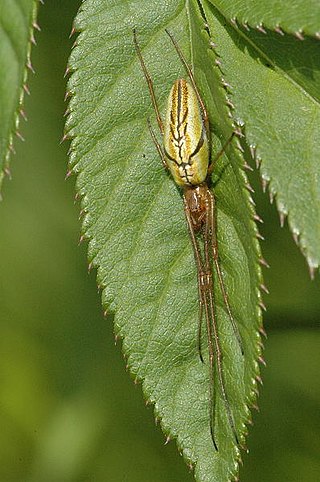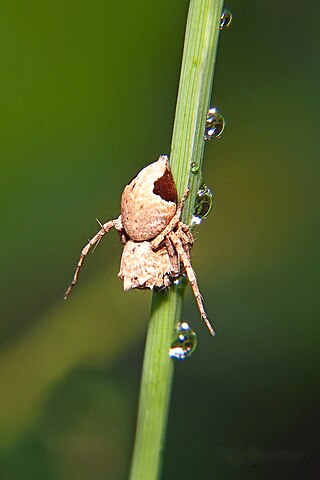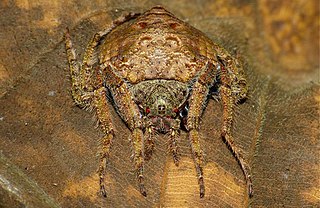
Orb-weaver spiders are members of the spider family Araneidae. They are the most common group of builders of spiral wheel-shaped webs often found in gardens, fields, and forests. The English word "orb" can mean "circular", hence the English name of the group. Araneids have eight similar eyes, hairy or spiny legs, and no stridulating organs.

The spider genus Steatoda, in the family Theridiidae, includes about 120 recognized species, distributed around the world. One common name is cupboard spider, for many species build their webs in dark, sheltered, undisturbed places around the house or garden, in sheds and garages, under garden, compost bins, and the like. Signs of the cupboard spider include small white spots of spider droppings, like small splashes of paint, on the floor underneath the web.

Philoponella is a genus of uloborid spiders. Like all Uloboridae, these species have no venom.

Castianeira is a genus of ant-like corinnid sac spiders first described by Eugen von Keyserling in 1879. They are found in Eurasia, Africa, and the Americas, but are absent from Australia. Twenty-six species are native to North America, and at least twice as many are native to Mexico and Central America.

Acanthoctenus is a genus of Central to South American wandering spiders first described by Eugen von Keyserling in 1877.

Tetragnatha is a genus of long-jawed orb-weavers found all over the world. It was first described by Pierre André Latreille in 1804, and it contains hundreds of species. Most occur in the tropics and subtropics, and many can run over water. They are commonly called stretch spiders in reference to their elongated body form and their ability to hide on blades of grass or similar elongated substrates by stretching their front legs forward and the others behind them. The name Tetragnatha is derived from Greek, tetra- a numerical prefix referring to four and gnatha meaning "jaw". Evolution to cursorial behavior occurred long ago in a few different species, the most studied being those found on the Hawaiian islands. One of the biggest and most common species is T. extensa, which has a holarctic distribution. It can be found near lakes, river banks or swamps. Large numbers of individuals can often be found in reeds, tall grass, and around minor trees and shrubs.
Segestrioides is a genus of South American coneweb spiders that was first described by Eugen von Keyserling in 1883. Originally placed with the recluse spiders, it was moved to the coneweb spiders in 1983.
Caloctenus is a genus of wandering spiders first described by Eugen von Keyserling in 1877.
Taczanowskia is a genus of orb-weaver spiders first described by Eugen von Keyserling in 1879. Contrary to the common name of the group, spiders of the genus Taczanowskia do not build webs and are furtive hunters, deceiving their prey by producing sex pheromones that attract male moths, and catching their prey by using a pair of enlarged claws at the tip of their anterior legs.

Hamataliwa is a genus of lynx spiders that was first described by Eugen von Keyserling in 1887.

Dolophones conifera, known as the wrap-around spider, is a species of spider in the family Araneidae indigenous to Australia. It is named for its ability to flatten and wrap its body around tree limbs as camouflage. It is found in Western Australia along with several other species from the genus Dolophones, and was first described in 1886.
Liocranoides is a genus of American false wolf spiders that was first described by Eugen von Keyserling in 1881. They live in habitats with cold surfaces, such as caves. It was transferred from the sac spiders to the Tengellidae in 1967, which was later merged with Zoropsidae.
Exalbidion is a genus of comb-footed spiders that was first described by J. Wunderlich in 1995.
Gmogala is a monotypic genus of South Pacific comb-footed spiders containing the single species, Gmogala scarabaeus. It was first described by Eugen von Keyserling in 1890, and is found in Australia and Papua New Guinea.

Xenoctenidae is a family of araneomorph spiders separated from Miturgidae in 2017.

Alpaida is a genus of South American orb-weaver spiders first described by Octavius Pickard-Cambridge in 1889.

Gasteracantha westringi is a species of spiny orb-weaver spider in the genus Gasteracantha. It is found in Australasia, including New Caledonia and Norfolk Island, and it has a wing-shaped abdomen armed with red and black spines.

Hortophora is a genus of South Pacific orb-weaver spiders first described by V. W. Framenau, R. L. C. Baptista and F. S. M. Oliveira in 2021.












